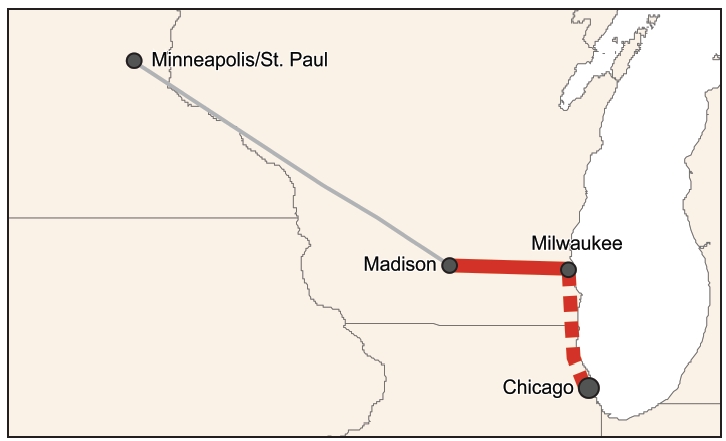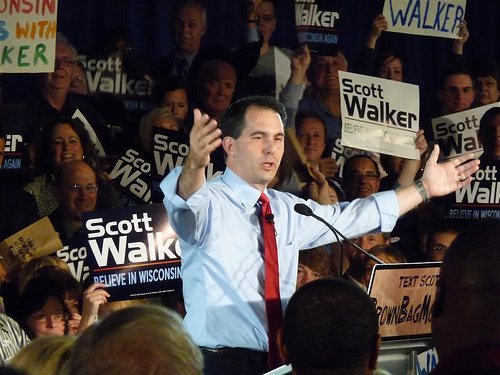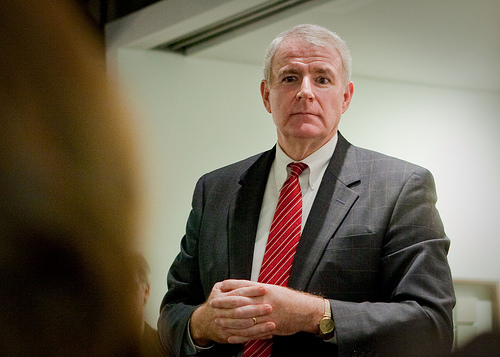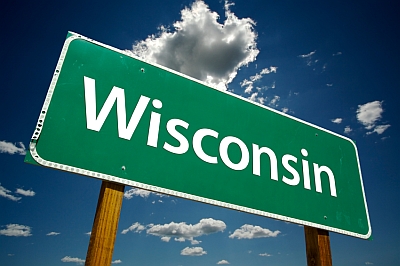For a glimpse at the future of Wisconsin, look to the recent past of Milwaukee. The city’s mayor, Tom Barrett (D), is running for governor against Milwaukee County Executive Scott Walker (R). The two have disagreed plenty in the past, and their local clashes over clean energy and mass transit reveal just how sharply their visions for the state diverge.
 The Department of Transportation plans to lay a foundation for high-speed rail from Chicago to Milwaukee, a line to Madison, and eventually extend it to Minneapolis.Image: Whitehouse.gov [PDF]Walker, who has a six-point lead in recent polls, has drawn national attention for promising to block a new rail line that would connect Milwaukee to Madison, and eventually help link Chicago to Minneapolis. Walker wants to send $810 million in federal construction funding back to Washington — a move that a frustrated Transportation Secretary Ray LaHood compared to a state refusing to take part in President Eisenhower’s interstate highway plan in the 1950s.) Locally, Walker has fought for years against more funding for Milwaukee County’s bus system, which has been hit especially hard by the recession and a public-school decision to use private buses instead of the county fleet. He essentially told officials to choose between continued fare increases or service cuts for next year, saying more county tax support was off the table. Barrett, in contrast, is an enthusiastic transit supporter, but he’s had less power to fund it.
The Department of Transportation plans to lay a foundation for high-speed rail from Chicago to Milwaukee, a line to Madison, and eventually extend it to Minneapolis.Image: Whitehouse.gov [PDF]Walker, who has a six-point lead in recent polls, has drawn national attention for promising to block a new rail line that would connect Milwaukee to Madison, and eventually help link Chicago to Minneapolis. Walker wants to send $810 million in federal construction funding back to Washington — a move that a frustrated Transportation Secretary Ray LaHood compared to a state refusing to take part in President Eisenhower’s interstate highway plan in the 1950s.) Locally, Walker has fought for years against more funding for Milwaukee County’s bus system, which has been hit especially hard by the recession and a public-school decision to use private buses instead of the county fleet. He essentially told officials to choose between continued fare increases or service cuts for next year, saying more county tax support was off the table. Barrett, in contrast, is an enthusiastic transit supporter, but he’s had less power to fund it.
The mayor has had more control over economic renewal in the area. He’s focused on the city’s Menomonee Valley, which was once the state’s industrial powerhouse, then a brownfield, and now, Barrett hopes, a resurgent manufacturing park. He worked to attract two Spanish companies, train-car builder Talgo and wind-turbine-generator maker Ingeteam, and Helios USA, a local solar-panel startup, to the valley. Walker, for his part, criticized Barrett and outgoing Democratic Gov. Jim Doyle for their handing of a Talgo no-bid state contract to build two Amtrak trains.
At the state level, the candidates disagreed on the Clean Energy Jobs Act that died in the state Senate on Earth Day this spring. It would have beefed up the state’s modest renewable energy standard and building efficiency code, incorporated a passel of recommendations from Gov. Doyle’s Task Force on Global Warming, and created an estimated 15,000 jobs by 2025.
Walker has made his opposition to Obama’s rail and clean-energy plans major parts of his campaign. He lashes out at what he calls a “radical environmental” agenda, a phrase he’s used in a campaign ad against Barrett and in a full-page newspaper ad [PDF] against President Obama that ran on the day of an Obama visit.
 WalkerPhoto: WisPolitics.comThat puts Walker out of step with Wisconsin’s history of bipartisan support for environmental efforts. Ten years ago, Republican Gov. Tommy Thompson signed a smart-growth law that required local municipalities to develop comprehensive land-use plans. It’s resulted in more communities choosing pedestrian-friendly, mixed-use development over car-dependent sprawl, according Steve Hiniker of the group 1,000 Friends of Wisconsin.
WalkerPhoto: WisPolitics.comThat puts Walker out of step with Wisconsin’s history of bipartisan support for environmental efforts. Ten years ago, Republican Gov. Tommy Thompson signed a smart-growth law that required local municipalities to develop comprehensive land-use plans. It’s resulted in more communities choosing pedestrian-friendly, mixed-use development over car-dependent sprawl, according Steve Hiniker of the group 1,000 Friends of Wisconsin.
Tommy also supported high-speed rail and alternative-energy investment, according to Andy Olsen, senior policy advocate in Madison for the Environmental Law & Policy Center and a former Thompson staffer. Thompson understood that energy efficiency was especially important because the state spends $17 billion each year bringing in fuel from outside its borders.
“We have zero fossil-fuel reserves, we have no coal, no oil, no gas in the ground,” said Olsen. “So it really makes zero sense for a Wisconsin governor to oppose the policies we need to develop home-grown clean energy.
“When we have energy efficiency, those dollars stay at home, in the state’s economy. I used to write that in Tommy Thompson’s speeches in the ’90s. It used to be something that people got on a bipartisan basis. I’m not sure that’s the case anymore.”
Scott Walker
Walker is a former state assemblyman and eight-year county executive who shot his first campaign ads from his ’98 Saturn (with 100,000 miles on it). He explains in the video that he brings a brown-bag lunch every day, has given back more than $370,000 of his salary to the county over the years, and wants state government to be as frugal as he is.
His website says the state should “diversify our energy supply based on a balance of cost and sound science with an eye toward environmental impact,” though the only specific he offers is lifting the state’s moratorium on new nuclear plants. For what it’s worth, the site’s “green energy” page is blank.
Tom Barrett
 BarrettPhoto: Spreenkler
BarrettPhoto: Spreenkler
Barrett spent eight years in Congress (1992-2000), serving on the House Committee on Energy and Commerce and earning a 98 percent lifetime score from the League of Conservation Voters. As mayor, his work converting Milwaukee’s vehicle fleet to hybrid and biodiesel drew praise from the American Lung Association.
He worked to a launch a Property Assessed Clean Energy program to let homeowners pay for energy-saving retrofits over time, removing upfront-cost barriers (though such programs are currently suspended due to opposition from Fannie Mae and Freddie Mac).
Barrett criticized some parts of last session’s clean-energy bill as it acquired special-interest concessions. He says he’d work for a simplified version as governor. A clean-energy bill is essential for growing a cleantech sector, said Anne Sayers, political director of the state League of Conservation Voters. She notes that the state’s 10-percent-by-2015 renewable standard is weaker than most, and it’s the only state in the Midwest without a formal efficiency target for utilities.
“Our neighbors in the Midwest have decided they will be a part of the new clean energy economy,” Sayers said. “Wisconsin hasn’t made that decision yet, and we’re falling behind.”
——-
Note: Some of the comments below pre-date this story, since we launched our Gubernatorial Tutorial series before publishing this article. Let the conversation continue!



